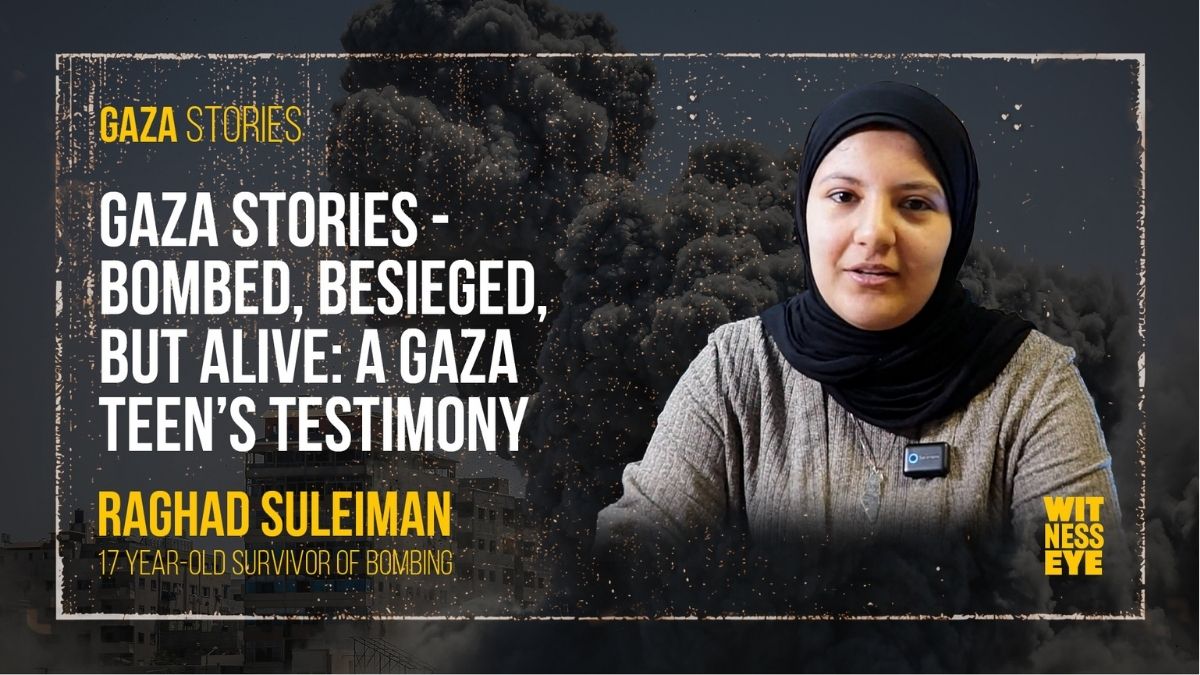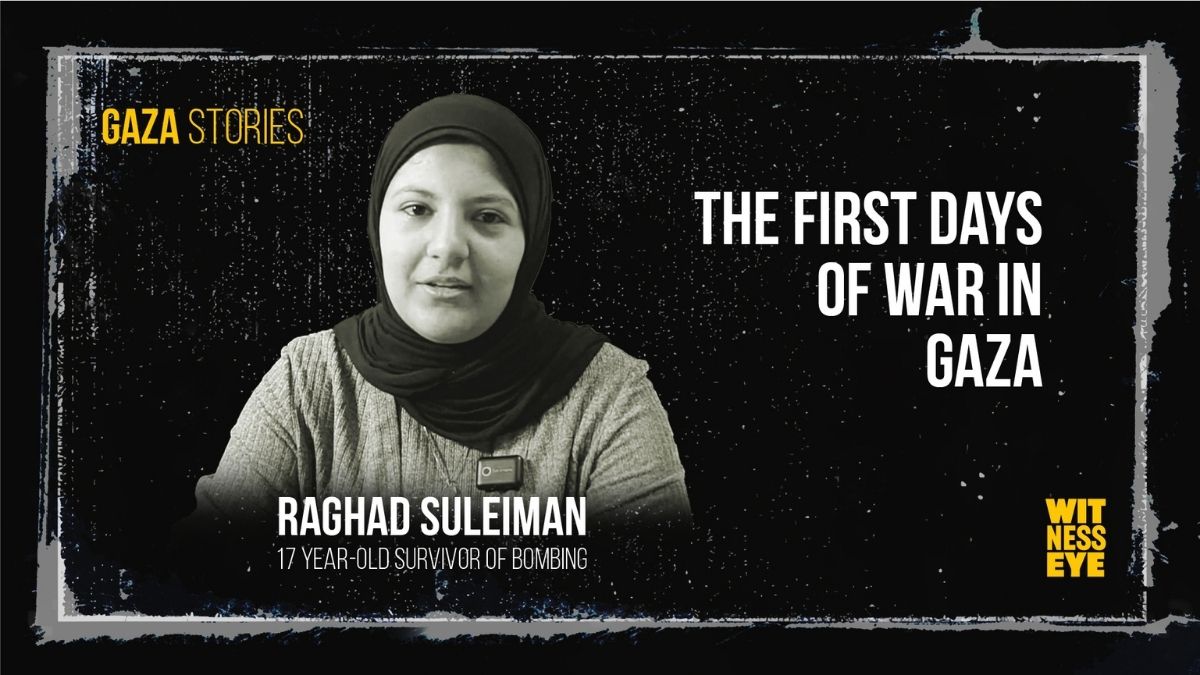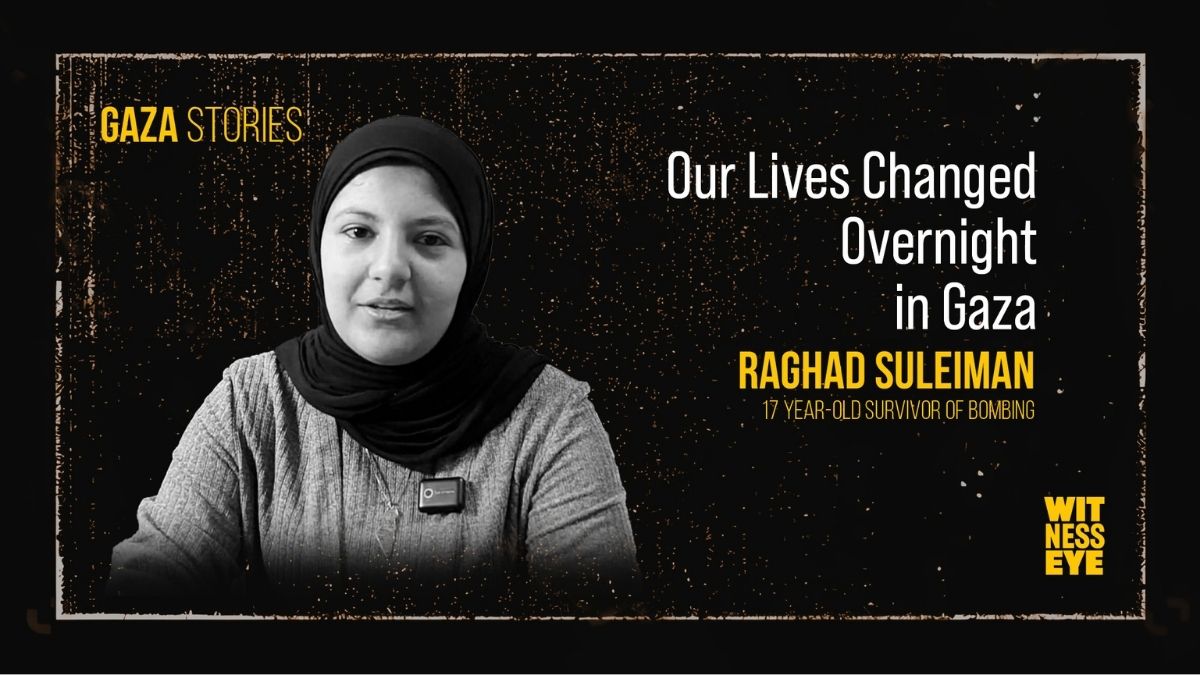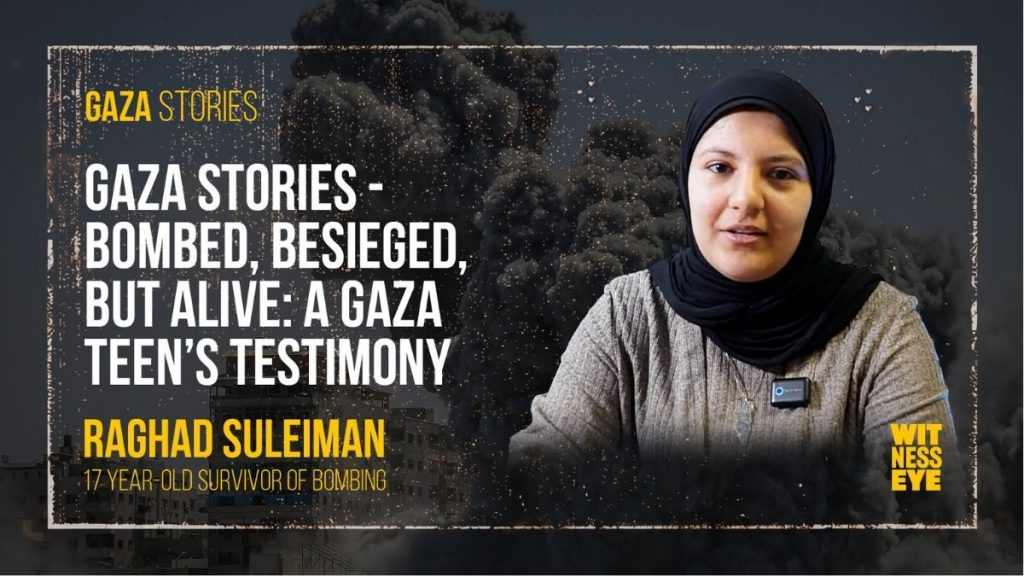
Gaza Stories shares Raghad Suleiman’s heartbreaking experience amid the Gaza genocide. A 17-year-old high school student, Raghad’s life was shattered on October 7th. The bombing forced her family to flee, but even in displacement, they were not safe. Her home was destroyed, and over 50 relatives were killed. The hospital she fled to for treatment became a site of terror. Despite her severe injuries, Raghad never lost hope. Her story is a painful reflection of the ongoing suffering in Gaza. It’s a testament to survival amidst unspeakable tragedy.

The First Days of War in Gaza
Raghad Suleiman recounts the terror that struck Gaza on October 7th, 2023. Life in Gaza, once normal, quickly turned into chaos and destruction. For Raghad, a 17-year-old high school student, the war obliterated her peaceful existence. She used to go to school and spend time with friends, enjoying the simplicity of adolescence. However, the brutal reality of war arrived without warning, altering everything she knew.
“The first days of the war in Gaza were unimaginable,” Raghad recalls. “We could hear explosions, and the ground shook with the force of bombings.” The situation was dire, especially in northern Gaza, where the intensity of airstrikes and ground assaults was felt the most. “We tried to go to the market for food, but supplies were quickly running out,” she explains. The panic in Gaza was palpable, and as bombs fell around them, survival became the primary focus. Despite all the chaos, Raghad and her family tried to cling to the hope that their lives would return to normal, but they soon realized that would never be the case.

Our Lives Changed Overnight in Gaza
Before the war, Raghad’s life was simple and filled with the usual teenage routines. She lived with her family in Jabalia, a region that became one of the most targeted areas in Gaza. “Jabalia was like any other place. We had our school, our friends, and our routines,” she says. But when the bombs began falling, everything changed. The family decided (wisam atallah’a neden bağlandığını anlayamadım?) to flee, hoping to find safety in another home, but they were never truly safe. “We moved to my relative’s house, but it was bombed too,” she says. “There was no escape.”
Raghad’s memory of those early days is filled with fear and confusion. “The war didn’t just destroy buildings; it destroyed our sense of security,” she shares. Every place they sought refuge was eventually hit by airstrikes or bombings. “We lived in constant fear, not knowing where would be safe next,” Raghad explains. Even when they thought they were far from the fighting, it followed them. “There was no escape from the constant terror,” she says. This marked the end of the life Raghad once knew and the beginning of an unimaginable struggle for survival.
Surviving the Bombing
Raghad Suleiman’s survival story is one of sheer luck amid unimaginable tragedy. Her family’s shelter, where over 50 people had gathered to stay safe from the airstrikes, was bombed without warning. “Over 50 people were in the house,” Raghad recalls, visibly shaken by the memory. “Most of them were in the upper floors and were martyred. I was on the lower floor, so I survived.” The bombing caused severe damage to the house, leaving Raghad with injuries that would require numerous surgeries, particularly to her foot. “The bombing came without warning,” she says. “It was so sudden.” The chaos left Raghad traumatized, not only physically but emotionally, as she watched loved ones perish in the blast. Her survival, despite the circumstances, seemed almost impossible, yet she clung to the will to live.
In the aftermath of the bombing, Raghad faced immense physical pain and grief. “The destruction was total, and most of the people in the house didn’t make it,” she shares, recalling the scene with deep sorrow. Despite her injuries, Raghad remained in shock, unable to comprehend the magnitude of the attack. “We were just preparing for prayer when everything was destroyed,” she says. “We never expected this.” The experience left her scarred, physically and emotionally, but her survival was a testament to her strength amid unimaginable loss .

When the Homes Become Graves in Gaza
The destruction of Raghad’s house was not only a personal tragedy but also a horrific symbol of the violence that engulfed Gaza. “More than 50 martyrs came out of the house,” Raghad states, her voice filled with sorrow. “But those of us on the lower floors, like me, were lucky to be alive.” The upper floors, where most of the people had taken shelter, were completely destroyed in the bombing. Tragically, those on the upper levels did not survive. “We were performing ablution to prepare for prayer when the house was hit,” Raghad recalls. Her voice trembles as she remembers the suddenness of the attack, the impact that changed her life forever.
The bombing took place at the most vulnerable moment—while Raghad and her family were preparing for prayer, an act of peace and devotion. “It was the moment we least expected it,” she says. “It was a peaceful moment that turned into chaos.” The devastation was not just physical; it destroyed the sense of security that Raghad and her family had fought so hard to preserve. The attack served as a harsh reminder of the brutal reality they faced in Gaza.
Israel’s Strikes Leave Gaza Without Medical Relief
After the bombing, Raghad was rushed to the Indonesian Hospital, where the conditions were catastrophic. “When I arrived, I was lying on the floor, bleeding, with no proper medical care,” she recalls, struggling to hold back tears. “There were no bandages, no equipment—just people lying on the floor.” The hospital was overcrowded, with countless people, including children and the elderly, seeking treatment for their injuries. With the overwhelming influx of casualties, Raghad’s injury was unfortunately not a priority. “I was left on the floor for hours, then a doctor finally looked at my injury,” she says. “But they were too busy to care for everyone.” For an entire day, she received no proper medical treatment, adding to her suffering. The lack of basic medical supplies and equipment only amplified the horrors of the situation.
The hospital was a scene of chaos and despair, where survival seemed more like luck than a certainty. “There was no place for us to lie down,” Raghad explains, her voice trembling as she recalls the pain and helplessness. “We were left on the floor, in pain and without treatment.” Despite the desperate need for care, the staff was stretched thin, unable to manage the overwhelming number of patients. The conditions in the hospital were a microcosm of the suffering that civilians in Gaza endured. “I was bleeding, but my injury was considered minor compared to others,” Raghad reflects. The overcrowded and under-resourced hospital became a place of intense suffering, where the wounded waited, hoping for the care they desperately needed.
The Hospital Was a War Zone – Gaza Stories
Raghad’s experience at the Indonesian Hospital highlighted the grim realities of healthcare in Gaza during the war. “The hospital was overwhelmed with the injured, and there was no place for us to lie down,” she explains. The sheer number of casualties forced doctors and nurses to prioritize the most critical cases, leaving others to suffer in agony. “We were left on the floor, in pain and without treatment,” Raghad continues. The hospital became a war zone, where the injured were forced to wait for hours or even days, hoping to receive medical attention. The medical staff, though doing their best, were unable to keep up with the overwhelming demand for care.
For Raghad, the experience was traumatic not only because of her injuries but also because of the constant threat of death. “The doctors were too busy to care for everyone,” she says. In a place meant for healing, the lack of resources and staff turned the hospital into a place of fear and uncertainty. The ongoing violence and chaos outside created an environment where even the most basic care was a luxury. “It was a war zone, and we were all just waiting for any help to come,” Raghad recalls. The hospital became a symbol of the brutal conditions civilians in Gaza were forced to endure.
The Siege of Indonesian Hospital by Israeli Forces
Raghad vividly recalls the terrifying siege of the Indonesian Hospital by Israeli forces, a harrowing experience that left her deeply shaken.
“We could hear the tanks getting closer, and then they started bombing the hospital,”
she says, her voice reflecting the trauma of that moment. The sheer intensity of the assault was overwhelming, with explosions rocking the building and turning the hospital into a battlefield. “There were more than 15 martyrs just from that attack. People were already injured, but the bombing didn’t stop,” Raghad explains. Despite the chaos, the injured patients, doctors, and displaced civilians had no choice but to remain trapped inside, enduring more violence and uncertainty.
The Israeli forces’ actions against the hospital were calculated and deliberate.
“It was complete chaos. People were lying on the ground with their hands on their necks, trying not to move. If anyone moved, they were shot.”
Raghad recalls. The situation became even more nightmarish as the soldiers released dogs to intimidate and attack the wounded.
“They released dogs on the people in the hospital. Some were eaten by the dogs. It was inhumane”
she says. Raghad’s recounting of these horrific events highlights the extreme cruelty she witnessed, and it is a chilling reminder of the atrocities that took place within the walls of what should have been a sanctuary for the injured.
From Gaza to Turkey: A Journey of Survival
After surviving the brutal siege and bombing, Raghad was evacuated to Turkey for medical treatment. “The situation in the hospitals in Gaza was dire. Even after the ceasefire, I was still not getting the treatment I needed,” she explains. The long wait for adequate medical care left her struggling to get the proper treatment. Despite the limited resources in Gaza, she was resilient. However, the journey didn’t end with her evacuation. Her injuries continued to require surgeries, and Raghad remained hopeful despite the challenges. “I am improving, but there is still a long way to go,” she admits. The road to recovery was long, but she was determined to move forward.
Despite everything she has been through, Raghad is determined to continue her education. “I want to finish my high school education remotely, despite everything,” she says. Her resilience is a testament to her strength, but the journey ahead remains challenging. “I’m trying to find some normalcy in my life again. Even if I can’t return to school normally, I’ll do what I can.” She acknowledges that while she can’t return to school as she once dreamed, she is determined to continue her studies from afar. This strength is a reflection of her hope for a better future, despite everything she’s lost and the immense struggles she continues to face.
Life in the South of Gaza
When Raghad’s family was displaced to the south of Gaza during the truce, they hoped for a reprieve from the horrors they had experienced in the north. “There was overcrowding, limited healthcare, and basic supplies were scarce,” she explains. Despite the promise of better conditions in the south, the situation remained dire. The hospitals were just as overwhelmed, with no significant improvement in the availability of medical care or supplies. “We thought it would be better, but it was the same,” Raghad says, reflecting on the unfulfilled expectations of safety and support in the south. The lack of proper infrastructure and aid exacerbated the already fragile situation, leaving families like hers struggling to survive.
The harsh reality of life in the south mirrored the difficulties they faced in the north. “There was no electricity, no food, and no water,” Raghad remembers. Even though they were far from the frontline of the conflict, the ongoing war still cast a heavy shadow over their lives. The overcrowding meant that families had to share limited space, and basic necessities were often rationed. “People were living in makeshift shelters, with nothing to call their own,” she adds. For Raghad’s family, the promise of a better life in the south quickly turned into another chapter of suffering in a war-torn land.
Gaza Stories – No Escape From the War’s Grasp
Raghad’s family, still residing in the north of Gaza, remains trapped under the brutal realities of constant bombing. “They live without electricity, without water, without food,” she explains. Life for them is marked by an unending struggle to find safety amidst the devastation. The war has left them with nothing, forcing them to survive in the harshest conditions imaginable. “There’s nothing left in Gaza,” Raghad says, her voice heavy with sorrow. Despite their best efforts to find refuge, the relentless attacks have left them with no place to go and no way out of the war’s cruel grasp.
The displacement and deprivation are ongoing, as the northern region of Gaza has become nearly uninhabitable. Raghad’s family is living in tents, exposed to the elements and without basic necessities. “They are constantly on the move, seeking shelter in whatever space they can find,” she says. These makeshift shelters offer little protection from the relentless bombings, leaving her family in constant fear for their lives. The lack of essential resources and the destruction of infrastructure have made survival even harder. For Raghad, the feeling of helplessness is overwhelming as she watches her loved ones endure this unimaginable suffering.

One Story, Countless Victims: Gaza Under Israeli Assault
Raghad’s story represents just one of the countless untold tales of civilians suffering in Gaza. Through her words, we gain a glimpse into the unimaginable hardships faced by innocent families who have become pawns in the ongoing conflict. “This is not just war. It is genocide,” Raghad declares, highlighting the devastating reality that many people around the world remain unaware of. Her experience is a stark reminder of the human cost of violence and the brutal toll it takes on those who are caught in its path. Raghad’s story is not just a personal tragedy, but a reflection of the collective suffering endured by countless others.
For Raghad and others like her, survival is a daily battle. “The world needs to see what is happening. We are fighting for our survival,” she says, emphasizing the urgent need for global attention. The atrocities committed against civilians, the widespread displacement, and the complete destruction of entire communities are part of the grim reality that she and so many others face. Her plea is not just for her own safety but for the world to recognize the dire circumstances and take action to prevent further devastation. The pain she endures represents the pain of many—faces of war often left unseen by the global community.
Gaza Stories – The Need for Global Action on Gaza
Gaza Stories sheds light on the painful and harrowing experiences of those caught in the ongoing conflict. Raghad Suleiman’s testimony is just one of many stories from Gaza that demand attention and action. The world has witnessed the brutality, the destruction, and the suffering, but it is time for this suffering to be recognized, documented, and addressed. Their stories are more than just accounts of survival—they are urgent calls for justice, peace, and humanitarian aid. The situation in Gaza is worsening, and the people are being left to face unspeakable horrors. Gaza Stories is a beacon for all those affected by the conflict, bringing attention to their plight in a world that often overlooks them.
It is essential that the world listens to these stories and takes concrete steps to end the violence. Gaza Stories does more than just share accounts of tragedy—it holds a mirror to the world, reflecting the immense human cost of conflict. It is through these stories that we can understand the true depth of the crisis and why immediate action is necessary. The ongoing suffering in Gaza cannot be ignored, and Gaza Stories is a testament to the resilience of those who refuse to be forgotten. As we reflect on Raghad’s journey and the countless other testimonies shared by Gaza Stories, it becomes clear that we are all responsible for the future of Gaza. Gaza Stories reminds us all of our shared humanity and the urgent need to stand up for those who are voiceless.
Now, hear the story of Raghad Suleiman, a seventeen-year-old who survived the bombing that killed more than 50 of her relatives. From a hospital floor under siege—where even the wounded face unleashed dogs—she speaks of loss, survival, and the unbroken will of Gaza’s youth.
